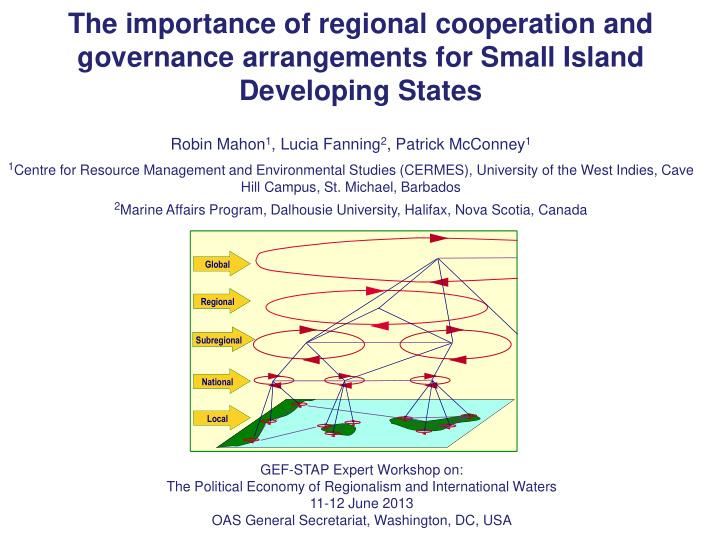



The importance of regional cooperation and governance arrangements for Small Island Developing States Robin Mahon 1 , Lucia Fanning 2 , Patrick McConney 1 1 Centre for Resource Management and Environmental Studies (CERMES), University of the West Indies, Cave Hill Campus, St. Michael, Barbados 2 Marine Affairs Program, Dalhousie University, Halifax, Nova Scotia, Canada Global Regional Subregional National Local GEF-STAP Expert Workshop on: The Political Economy of Regionalism and International Waters 11-12 June 2013 OAS General Secretariat, Washington, DC, USA
Regional cooperation and governance arrangements Focus on SIDS because they have the most to gain from effective regional arrangements Primarily about coping with limited financial and human capacity in SIDS. Cooperation arrangements can facilitate: o Sharing expertise o Multi-country initiatives that take advantage of economies of scale o Collective representation o Governance at appropriate geographical scales
Regional cooperation and governance arrangements Regional and subregional cooperation has attendant tensions, primarily relating to sovereignty, balance of power between levels, and distribution of benefits. Familiar ground, so… How can GEF Projects promote regional cooperation? How the CLME project dealt with regional cooperation issues in the Wider Caribbean Region.
How the CLME Project dealt with regional cooperation The Project: Was sensitive to the complexity and importance of regional arrangements from the outset Addressed these in the design of the project Engaged with 25 regional or subregional organisations in the WCR with some degree of responsibility for sustainable use of the ocean. Wanted to be sure that it understood the mandates and activities of these organisations, and their interrelationships So the SAP could adequately provide for their engagement in a regional framework or network.
Building regional cooperation requires a conceptual framework Ostrom’s Institutional Analysis Framework Global Regional Subregional National Local Scale Nesting Fit of institutions to ecosystems Interplay of organizations Interactive Regime complexes Approach to Network governance Governance Subsidiarity
The LME governance framework ANALYSIS AND ADVICE DATA AND INFORM- A multi-level policy-cycle based ATION DECISION MAKING governance framework REVIEW AND EVALUATION IMPLEMENT -ATION Global Policy cycles must be: Regional Complete Linked Subregional vertically Linked laterally National Diversity of policy Local processes as appropriate
The framework was used to design the CLME Project Implemented as a series of partnerships with key organisations Comprised PAG Facilitated engagement of all organisations
Framework was used to explore roles and relationships of organisations Each other Countries Global arena
The framework as a tool for assessment and intervention Focused on: Visioning and Global Global marine policy cycle principles at the level of the whole system. The gaps, overlaps Regional ocean governance policy cycle and networking among regional organizations; Regional/ Regional/subregional Architecture of subregional fisheries cycle specific Reef Flyingfish arrangements and ecosystem cycle cycle associated policy processes; Pelagic fishery cycle The national- National regional interface; Overarching coordination and Local integration
How the CLME Project dealt with regional cooperation Regional arrangements were at the forefront in the CLME project Issues of resource management, pollution, habitat degradation were seen in the context of these governance arrangements Framework provided the basis for a discussion about regional arrangements Concept of an emerging governance complex or governance regime became a part of the discussion. Ultimately, the SAP was designed around a regional governance framework. The project did not take on the persona of a regional organization, but kept to its role as a facilitator of regional cooperation.
REGI GIONA ONAL GOVE VERNANC RNANCE E FRAME MEWOR ORK FOR LIVING ING MARINE RINE RESO SOUR URCE CES REGI GION ON-WIDE WIDE OCEAN EAN POLICY CY LEVEL VEL Regional ocean governance policy mechanism (Caribbean Sea Commission, or equivalent, with membership of all relevant regional IGOs and NGOs) PLANN NNING ING AND OPERA RATIONA TIONAL LEVELS VELS Fishe sheri ries es Pelagi gic c fisher erie ies ecos osystem em Reef ef fisher eries ies ecos osystem em (CRFM/OESPESCA/FAO) Lobster Large pelagics Ocean- wide Regional CA lobster ( OSPESCA ) Reef fisheries and Flyingfish (CRFM) biodiversity (UNEP) Other lobster Continental inental shelf elf fisher eries ies (CRFM/ ecos osyst ystem em (CRFM/FAO) WECAFC) North Brazil Other Shelf continental ecosystem shelf Habitat tat Polluti tion destr tructi uction on (UNEP-LBS/OSP, MARPOL IMO) (UNEP-SPAW)
Problems with developing and gaining acceptance for the RGF New language and idea set – difficult conversation But aren't we going to actually do anything? Organisational tensions Roles Overarching coordination GEF PCU tensions
Some conclusions and outcomes Taking a structured approach allowed for: Regional complexity to be broken down into component parts that can be assessed. Development of interventions that target weak parts of the framework and strengthen them, with the long-term goal of a fully functional framework. Organizational actors to see The framework as a whole, and Their role in it, who they should be interacting with and what needs to be done to enhance their capacity to play that role. The conversation has been shifted.
Thank you
Recommend
More recommend